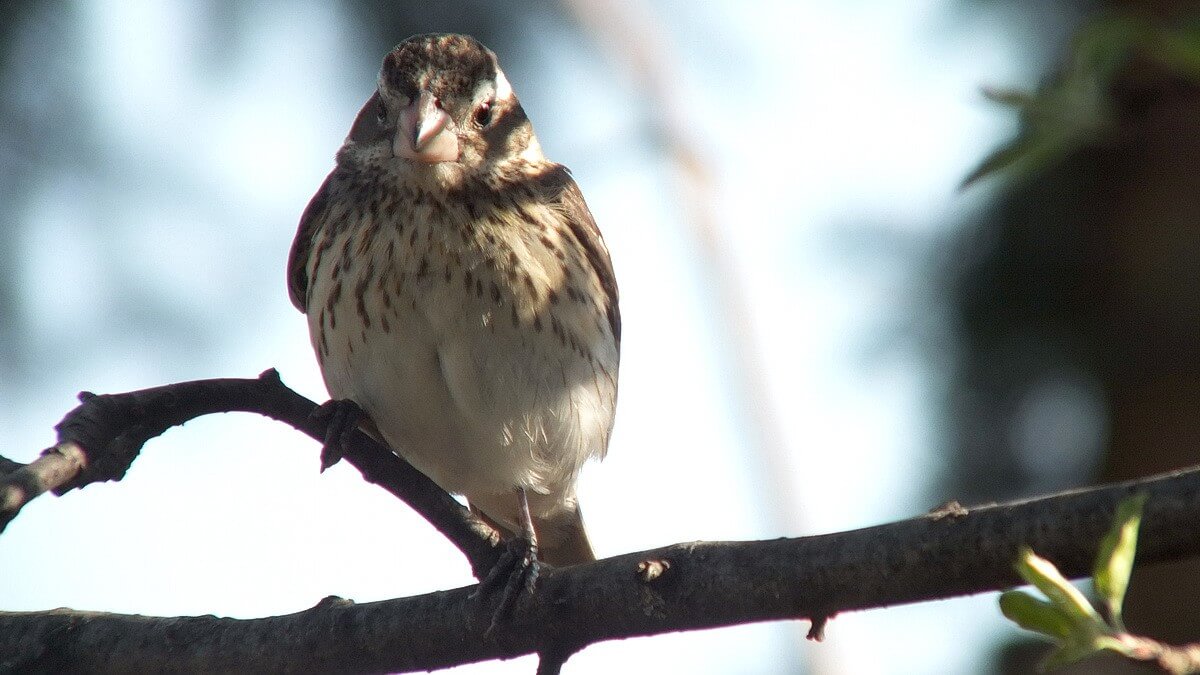Rose-breasted Female Grosbeak In Our Backyard
In years past, on a couple of rare occasions, we have had a male Rose-breasted Grosbeak drop by our backyard during spring migration. This past spring, a pair of males spent several days around our property enjoying the bird food and water fountain before moving on. Bob and I were pleasantly surprised late one afternoon to see that a female Rose- breasted Grosbeak had come to join in the free-for-all.
When first we spotted the unfamiliar bird in the birch tree, we thought it was a female Purple Finch…
like this one we saw at my dad’s place near Algonquin Provincial Park. The two females are quite similar, but note the difference in the colour of their beaks and legs.
Once closer observation was possible, when the bird landed near the patio door in the apple tree, her large, heavy bill with the slightly curved upper mandible confirmed the bird was a grosbeak, and the strong stripe over the eyes and down the middle of the crown gave us the necessary details to confirm that we were looking at a female Rose-breasted Grosbeak.
The flamboyant males are much more striking with the cherry-red patch on their breasts, and against their black heads, the large horn-coloured beak stands out more prominently. The beak is the same colour in Rose-breasted Grosbeaks of all ages and both sexes, while their feet and eyes are all dark.
Female Rose-breasted Grosbeaks are similar in colour to the young males with brown being the predominant colour streaked heavily with black. Females have whitish underparts contrasted by thin, dark streaks on the breast. One difference is that females have wing linings that are yellow as opposed to the males’ red linings. Both females and immature males show white patches in the wings and tail. These songbirds are large and stocky as this plump specimen, bathed in morning sunshine, so aptly reveals.
My photographs of the female Grosbeak reigning supreme at the bird feeder are not the best action shots,
but they do convey the dominance over other bird species that she displayed for several days in a row.
The male Grosbeaks seemed to favour foraging on the ground beneath this feeder although they also visited the suet hanging from the birch tree.
When Rose-breasted Grosbeaks whistle a tune, it is a sweet, melodious song similar to that of an American Robin although it is reputed to be more subdued and mellow. The refined warbling is performed by both the males and females even when they are sitting on the nest. Whether building their nest, incubating the eggs or raising their nestlings, they are known to sing. The male will warble, for the most part, quietly while he takes his turn warming the eggs, and this goes on for extended periods through the day. Then the female relieves him of his duties for the remainder of the day and overnight, and quite adorably, the pair will sing quietly to one another as they exchange places on the nest.
Bob and I felt thrilled to have the female Rose-breasted Grosbeak with us for several days running, but then she followed in the flight path of the two males that had already vacated our property for a more ideal breeding spot. Like a lot of bird species, the female’s plumage was much less showy with its delicate shading, all the better to avoid detection by predators. We hope that we are lucky enough to see these birds again next spring.











